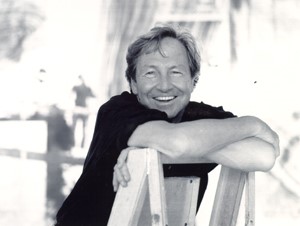Robert Rauschenberg
Visual Artist

1925 - 2008
Inducted in 1991
Biography
One of the truly influential artists of the 20th Century, Robert Rauschenberg created an enormous portfolio of work that today is represented in the permanent collections of art museums around the world.
Rauschenberg was a primary figure during the art world's effervescent 1950s and ‘60s, and became recognized as a major forerunner of American pop art, along with contemporaries Andy Warhol and Jasper Johns. Today, his work is generally regarded as a transition between abstract expressionism and pop art.
A native of Port Arthur, Texas, Rauschenberg (born as Milton Ernest Rauschenberg) grew up in a fundamentalist (Church of Christ) family. Reportedly, he briefly considered becoming a preacher but abandoned the idea by age 13, and abandoned religion altogether in his 20s.
Rauschenberg studied pharmacy, briefly, at the University of Texas, before enrolling at the Kansas City Art Institute in 1946. He spent 1947 in Paris, studying at the Académie Julien, where he met his future wife, painter Susan Weil. Both soon decided to move back to the states and train under noted artist Josef Albers at Black Mountain College in Ashville, North Carolina.
At Black Mountain, Rauchenberg was heavily influenced by avant-garde dancer and choreographer Merce Cunningham who taught there. He also met another Black Mountain teacher bound for fame, composer John Cage, whose wildly out-of-mainstream approach to music made an indelible impression on Rauchenberg's work for the rest of his life.
In 1949, Rauchenberg moved to New York City, marrying Weil the following year (the marriage produced one child before the couple divorced in 1953). To help make ends meet, Rauchenberg arranged window displays at Tiffany's.
In 1951, Rauchenberg had his first one-man show which opened at the Betty Parsons Gallery in Manhattan. After a brief return to Black Mountain, where he collaborated with Cage and Cunningham, he traveled to France, Spain and Italy, exhibiting in Florence and Rome.
By 1954, Rauchenberg was settled into a New York studio that he shared with Jasper Johns, a contemporary painter. Johns' career, like Rauchenberg's was poised to take off. When Europe's Pop Art movement made it to the U.S. in the late 1950s, both artists soon began to make profound impacts on the new genre, along with contemporaries Andy Warhol, Peter Max, Robert Indiana, George Segal, Claes Oldenberg and many others.
It was during the nascent growth of pop art in the U.S. that Rauchenberg established the style for which he's best known. He mixed both painting and sculpture, often from material he found from the streets of New York, to create what he called "combines." One of the first (and most famous) of these was a piece entitled "Monogram (1959) that incorporated such disparate items as a tire, a shoe heel, a police barrier and a stuffed goat.
As the pop art scene evolved, Rauchenberg's work became less three-dimensional. He turned photographs of current events that he found in popular magazines into collages of silk-screen prints. This style became a passion that carried him well into the 1990s, and became a platform from which he launched imaginative experiments with a wide variety of media and materials.
By the mid-1960s, Rauchenberg had attained stardom in the modern art world. In 1969, NASA invited him to the launch of Apollo 11, a project that put the first human on the moon. The experience inspired Rauchenberg's "Stoned Moon Series," a body of elaborately created prints (34 in all) that art historians consider one of the great print projects of the 20th Century.
In honor of his influence on the art of the last half of the 20th Century, in 1997 the Guggenheim Museum in New York City staged a major exhibition of Rauschenberg's work. In 1999, the PBS series "American Masters" broadcast a profile of his life and work narrated by actor and art-lover, the late Dennis Hopper.
Rauchenberg died in 2008 at his home on Captiva Island in Lee County.

